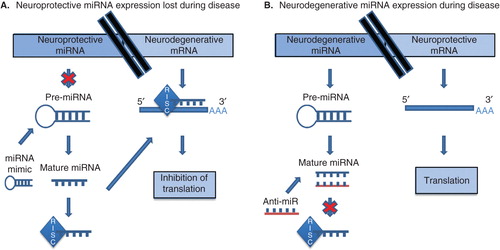Figures & data
Figure 1. Methods of miRNA manipulation in neurodegeneration. (A) Upon loss of expression of neuroprotective miRNA, miRNA mimics or synthetic miRNAs can be utilized for functional replacement. (B) Loss of expression of neuroprotective mRNA during disease due to repression by miRNA favoring neurodegeneration can be ameliorated by using anti-miRs (antisense inhibitors), multiple-target anti-miRNAs or miRNA sponges.

Figure 2. miRNA implicated in neurodegenerative disease. (A) Use of an miR-128 mimic in Parkinson’s-like mice resulted in improved motor function and downregulation of genes involved in the ERK1/2 signaling network which is implicated in excitotoxicity as well as downregulation of ion channels Citation[7]. (B) miR-29a is upregulated in SOD1G93A transgenic mice, a familial model of ALS. Amelioration of upregulation using anti-miR-29a resulted in alleviation of repression of target genes, and increased lifespan Citation[9]. (C) In a mouse model of Huntington’s disease, upregulation of miR-196a is protective against neurodegeneration and suppressed expression of HTT in the brain. Studies using patient-derived induced pluripotent stem cells overexpressing miR-196a also showed reduction of HTT levels as well as improvement in pathological aggregates Citation[14].
![Figure 2. miRNA implicated in neurodegenerative disease. (A) Use of an miR-128 mimic in Parkinson’s-like mice resulted in improved motor function and downregulation of genes involved in the ERK1/2 signaling network which is implicated in excitotoxicity as well as downregulation of ion channels Citation[7]. (B) miR-29a is upregulated in SOD1G93A transgenic mice, a familial model of ALS. Amelioration of upregulation using anti-miR-29a resulted in alleviation of repression of target genes, and increased lifespan Citation[9]. (C) In a mouse model of Huntington’s disease, upregulation of miR-196a is protective against neurodegeneration and suppressed expression of HTT in the brain. Studies using patient-derived induced pluripotent stem cells overexpressing miR-196a also showed reduction of HTT levels as well as improvement in pathological aggregates Citation[14].](/cms/asset/ee2524b0-bc73-4d0d-89ee-42647c9a3791/iedc_a_981254_f0002_oc.jpg)
Table 1. Delivery methods for miRNA administration to the CNS.
